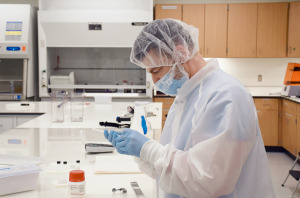In a bit of fortunate serendipity, it turns out that one of the world’s leading programs for the development of fiber-imbedded sensors is just a few miles down the road from a medical device company that’s extremely interested in incorporating such technology into its myriad products.
 Alexander Gumennik
Alexander Gumennik
Just a few weeks ago, Bloomington-based global medical technology company Cook Medical entered into a master research agreement with the Fibers and Additive Manufacturing Enabled Systems Laboratory at Indiana University’s Luddy School of Informatics, Computing and Engineering. The collaboration will explore incorporating FAME’s “smart fibers” into Cook’s products to facilitate continuous, real-time monitoring of various bodily functions during procedures.
“You can monitor with the fiber that is attached along the catheter in some form, so that whatever you deliver provides the outcome that you expect,” said Alexander Gumennik, assistant professor of intelligent systems engineering at the Luddy School and director of the FAMES Lab. “Then, in case that situation changes for good or for bad, you decide whether to stop delivering or maybe deliver something else.”
The technology in question is called Very Large-Scale Integration for Fibers, which uses a complex combination of materials processing techniques to imbed micro- and nano-sensors along the length of a cloth-like fiber. This sort of thing is of interest to companies like Cook, because it would theoretically allow real-time monitoring of a patient’s condition during insertion of, say, an endoscope or catheter.
 Sean Chambers
Sean Chambers
“All of our devices currently
are mechanical in nature,” said Sean Chambers, director of Cook Medical’s New Ventures corporate research program. “You can navigate the body with them, but they don’t provide any data to the clinician about local conditions. We saw a technology that allows Alexander’s team to make computers out of fibers. If you can put a computer in a fiber, then we could probably get that into our devices and be able to measure things like blood pressure and temperature.”
The current agreement between Cook and IU lasts 12 months. During that time, a small, integrated team from both institutions hopes to produce a prototype that incorporates a sensor thread into a Cook-manufactured guide wire and catheter. The device, if things go according to plan, would be able to monitor a patient’s blood pressure in real time and along the entire length of the instrument.
If the collaboration bears fruit, it could become the first step on the long road to producing and marketing multiple, sensor-equipped instruments. It would also become part of a national trend. Because right now, medical device builders are hurrying to put sensors onboard pretty much every instrument one would care to name.
“I know that it’s only been a couple of months, but this does seem like a good marriage of our technology with Cook medical products, or with the idea of using this technology in things like catheters, to be able to monitor patients in real time while they’re undergoing a procedure,” Gumennik said.
 Alexander Gumennik, director of Indiana University’s Fibers and Additive Manufacturing Enabled Systems Laboratory, is working with Cook Medical to embed “smart fibers” in medical devices. (Photoscourtesy of IU FAMES lab)
Alexander Gumennik, director of Indiana University’s Fibers and Additive Manufacturing Enabled Systems Laboratory, is working with Cook Medical to embed “smart fibers” in medical devices. (Photoscourtesy of IU FAMES lab)
Competition
If it works, it could theoretically be applied to hundreds of items manufactured by Cook. But tapping this potentially billion-dollar market has occurred to other medical device manufacturers, too. Especially given that the global medical device market is expected to reach more than $603 billion in sales in 2023, according to research by the Dutch information services company Wolters Kluwer.
“Embedding sensors into medical devices is a major trend in the industry right now,” said Amanda Pederson, news editor at Medical Device and Diagnostic Industry, which covers medical device and diagnostic design, development and manufacturing, as well as regulatory requirements. “There are so many examples of this trend that it would be difficult to list them all.”
One of the most interesting of these many products, Pederson said, is Zimmer Biomet’s Persona “smart knee” implant, which received FDA clearance last August. The implant can measure and determine range of motion, step count, walking speed and other gait metrics, which it then sends to Zimmer Biomet’s remote care management platform (developed with Apple to work with the Apple Watch) so surgeons and patients can access it.
“This is really cool because, in the past, surgeons would have to rely on whatever the patient told them regarding how their post-op recovery was going,” Pederson said. “This gives a more objective view of how the knee implant is actually performing for that individual patient.”
That last point illustrates the potential of sensor-embedded medical devices, be it the “smart” catheter prototype IU and Cook are working on, or the knee from Zimmer Biomet. The data from devices, be they permanent or not, will provide oceans of information on their effectiveness that will be useful to everyone from manufacturers honing their products to insurance companies deciding which procedures they want to cover in their plans.
It could also cut down the number of doctor visits for recovering patients.
“In the COVID era, remote monitoring also reduces the need for patients to be seen in person at their physician’s office,” Pederson said. “The goal is not just to collect the data but to make it easy for physicians [and, in some cases, the patients themselves] to get actionable insights from that data, for more personalized care.”
 IU FAMES Lab Director Alexander Gumennik, left, works with technical staff Tyson Miller and Troy Leffel. (Photo courtesy of IU FAMES lab)
IU FAMES Lab Director Alexander Gumennik, left, works with technical staff Tyson Miller and Troy Leffel. (Photo courtesy of IU FAMES lab)
Widespread applications
While using fiber technology in medical devices could be a huge market, Gumennik asserts that this technology, and others like it, will find applications far beyond hospitals. For instance, he believes smart fibers could assist with advancing quantum computing and could also be embedded in concrete as sensor sheets, to detect strains on buildings or internal cracking.
The technology used to embed computers and sensors into fiber is so recent that industries are still making blue-sky lists of the ways in which such an innovation might be used.
At this point, the IU and Cook teams meet biweekly to discuss advancements in the development of the specialized fiber needed for the catheter project. Although each new application requires production of a different type of fiber, embedded with different technological goodies and structural compounds, Gumennik said his lab is far enough along in the development process that creating a fiber for Cook doesn’t mean starting from scratch. The technology and the equipment needed to make sensor threads are more or less in hand, which means it’s more a matter of developing the right formula for this project.
“We have the manufacturing technology ready for us,” he said. “We have the toolbox that is universal, and we don’t start from developing the toolbox. We start by finding a material which, combined with the toolbox, can deliver our results.”
Fortunately, the amount of smart fiber needed for the initial IU/Cook collaboration is quite small.
“We are not even talking about 30 feet of fiber,” Gumennik said. “We are talking about fractions of tenths of centimeters, so fractions of feet.”
IU is investing $350,000 in the project, which, if successful, will result in the creation of a catheter and guidewire capable of monitoring a patient’s blood pressure along its entire length.
“We think it’s achievable, though 12 months is a little bit of an aggressive timeline,” Chambers said. “But we hope to demonstrate the functionality of being able to measure blood pressure in one of our devices.”
If the project works out, it could be the start of a longer relationship between Cook and the FAMES Lab. Along with the creation of a very extensive, very profitable line of Cook-built products.
“We think it could give us a platform to put a sensor into any of our catheters, guide wires, endoscopes, any minimally invasive product,” Chambers said. “And there are other technologies to be developed, so you could transmit power and send and receive signals. You could monitor a patient remotely, so they don’t have to come back for follow-up.
“That would really start changing medicine.”